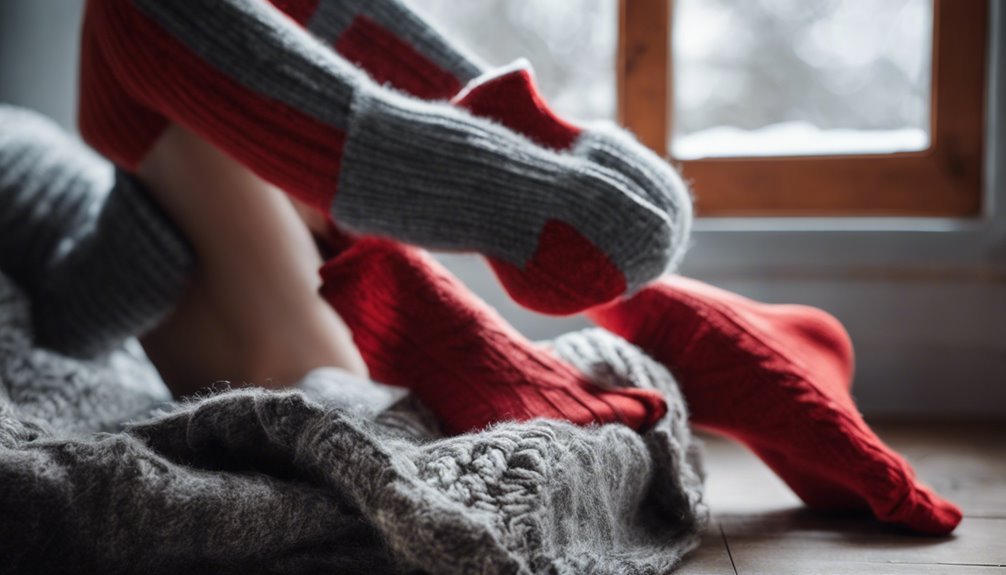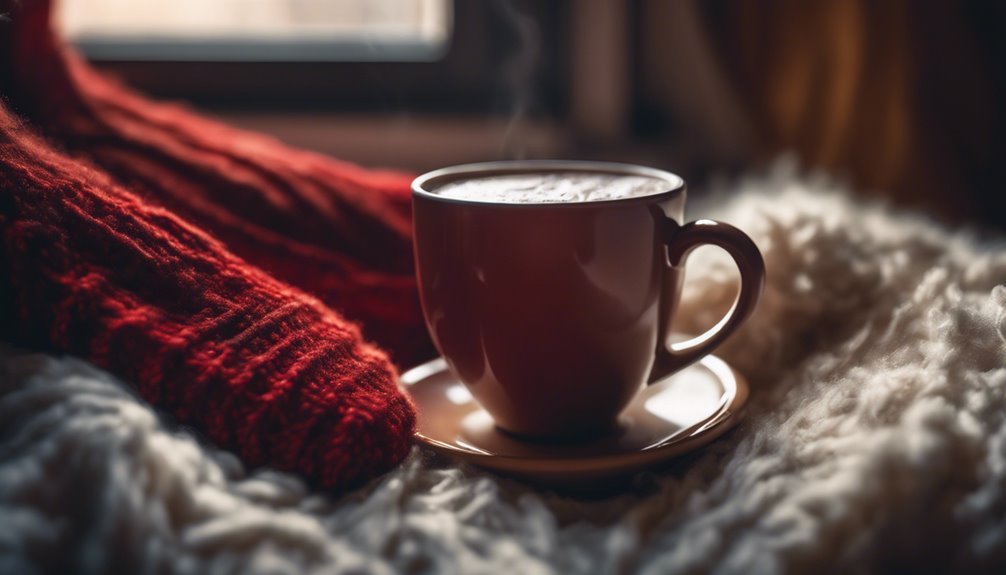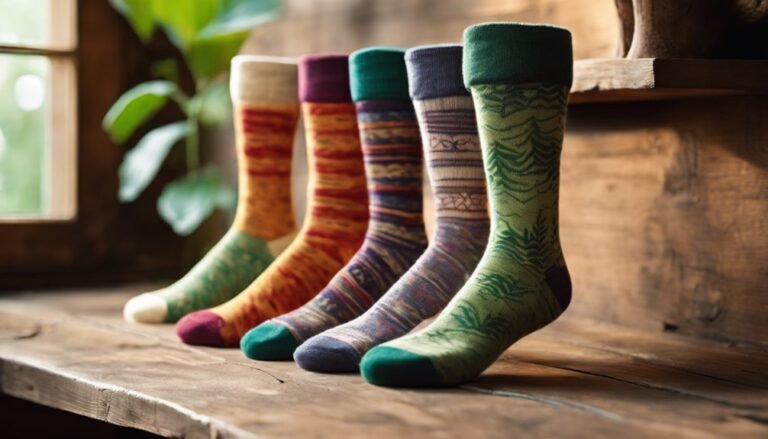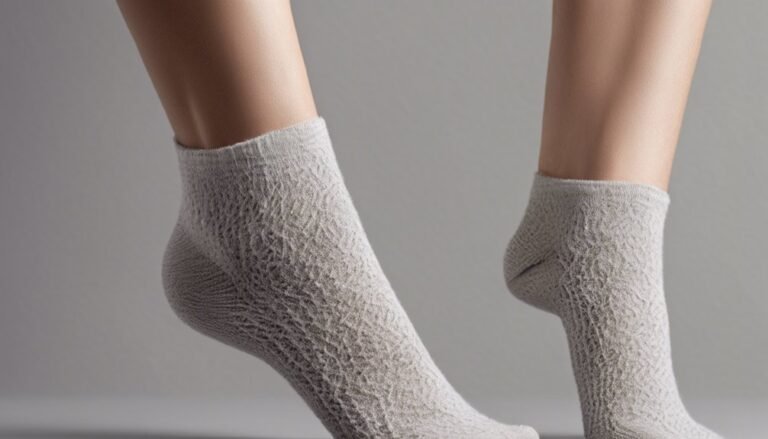Is Wearing Two Pairs of Socks Better for Warmth?
Wearing two pairs of socks can enhance warmth by increasing insulation and trapping heat around your feet, as long as your circulation isn't compromised. Materials like wool or moisture-wicking synthetics are ideal, but thicker socks may restrict blood flow if too snug. It's important to achieve a balance between added warmth and comfort. Understanding the nuances of sock choice and layering can make a significant difference in foot warmth during cold conditions. Consider exploring more insights on this topic.
The Science of Insulation and Heat Retention

When you think about keeping your feet warm, it's essential to understand the principles of insulation and heat retention. Footwear technology has advanced considerably, focusing on materials that enhance thermal regulation. Insulation works by trapping air, which acts as a buffer against the cold. When you wear two pairs of socks, you create additional layers that can improve insulation, but it's critical to make sure these layers don't compress, which can reduce their effectiveness. The right combination of materials—like wool or synthetic fibers—can optimize warmth without sacrificing comfort or mobility. Understanding how these elements interact can help you make informed decisions about your footwear choices, making certain your feet remain warm in any environment while enjoying the freedom to move.
Understanding Foot Temperature Regulation
Although you might not think about it often, understanding how your body regulates foot temperature is imperative for maintaining comfort in cold conditions. Your feet, like other body parts, rely on various regulation methods to maintain an ideal temperature. Blood flow plays a significant role; when you're cold, your body constricts blood vessels to prioritize core warmth, often leading to chilly feet.
Additionally, your skin's thermoreceptors help signal to your brain when it's time to adjust. Wearing two pairs of socks may aid in insulation, but it's also important to reflect on how moisture affects foot temperature. Wet feet lose heat rapidly, so ensuring dryness is essential for effective temperature regulation. By understanding these principles, you can better manage your foot comfort in cold environments.
The Role of Sock Material in Warmth
Sock material plays an essential role in determining how well your feet stay warm in colder conditions. Different sock materials possess unique thermal properties, impacting insulation and moisture management. Here's a quick breakdown of key materials:
- Wool: Excellent for insulation and wicking moisture away, keeping your feet dry.
- Synthetic fibers: Often lightweight and quick-drying, providing good warmth retention.
- Cotton: While comfortable, it absorbs moisture, leading to cold feet.
- Silk: Lightweight and smooth, it offers a layer of warmth but lacks durability.
Choosing the right sock materials is vital for maximizing warmth. You'll want a blend that keeps your feet cozy while eliminating moisture, allowing you the freedom to enjoy the outdoors without discomfort.
Pros and Cons of Double-Socking

Wearing two pairs of socks can provide increased insulation, helping to keep your feet warmer in cold conditions. However, you might also experience discomfort from the added bulk or issues with moisture management as sweat accumulates between the layers. It's crucial to weigh these pros and cons to determine if double-socking is right for you.
Increased Insulation Benefits
When temperatures drop, many people seek ways to enhance their warmth, and double-socking can provide increased insulation benefits. By layering socks, you create additional insulation layers that can greatly improve thermal efficiency. Here are some advantages of double-socking:
- Enhanced Warmth: Extra layers trap more heat around your feet.
- Moisture Management: The inner sock can wick moisture away, keeping your feet drier.
- Custom Fit: You can choose different sock materials for ideal comfort and fit.
- Versatility: It allows for adjustments based on activity levels or temperature changes.
Potential Discomfort Issues
Although double-socking can enhance warmth, it may also lead to potential discomfort issues. Wearing two pairs of socks can alter the fit, which might cause friction and pressure points on your feet. If the socks don't fit well together, you could experience pinching or slipping, compromising your foot health. Additionally, restricted circulation can result from overly tight socks, leading to numbness or coldness—defeating the purpose of extra warmth. Choosing the right combination of sock materials and ensuring that the fit remains comfortable is essential. Ultimately, while double-socking can provide increased insulation, you must balance warmth with comfort to maintain proper foot health, allowing for freedom of movement without sacrificing wellbeing.
Moisture Management Challenges
Double-socking can complicate moisture management, which is essential for keeping feet dry and comfortable. Here are some key points to take into account:
- Moisture Wicking: The inner sock should ideally be made of moisture-wicking material to draw sweat away from your skin.
- Breathable Fabrics: Verify that both socks are crafted from breathable fabrics to allow airflow and reduce dampness.
- Layering Issues: Two layers can trap heat and moisture if not properly designed, leading to discomfort.
- Scent Retention: More fabric can hold odors, requiring more frequent washing.
Comfort vs. Functionality: The Sock Debate
When considering socks, it's vital to weigh insulation against moisture management and overall fit. While layering can enhance warmth, it may also lead to discomfort if the socks don't fit properly or trap moisture. Finding the right balance between comfort and functionality is key for effective thermal regulation.
Layering for Insulation
Layering socks for insulation can greatly impact your overall warmth, especially in colder conditions. When considering thermal layering, it's vital to balance comfort and functionality. Here are four key factors to keep in mind:
- Sock Thickness: Thicker socks can trap more heat but may reduce circulation.
- Material: Opt for moisture-wicking fabrics to enhance insulation.
- Fit: Ascertain both pairs fit snugly to avoid bunching and cold spots.
- Type: Consider a base layer and an outer layer—like a thin liner under a thicker sock.
Moisture Management Issues
Although wearing two pairs of socks can enhance warmth, it can also lead to moisture management issues that affect overall comfort and functionality. When you layer socks, moisture can get trapped between them, leading to dampness and potential discomfort. This is where moisture-wicking sock technologies come into play.
| Feature | Single Pair of Socks | Double Pair of Socks |
|---|---|---|
| Moisture Wicking | High | Moderate |
| Comfort Level | Ideal | Variable |
| Risk of Odor | Low | Increased |
Choosing the right combination is essential. Opt for moisture-wicking materials to keep your feet dry, but be cautious; too much layering can compromise breathability, negating the benefits of your warmth strategy.
Fit and Comfort
Finding the right fit in socks is essential for balancing comfort and functionality. When considering sock fit, keep these factors in mind:
- Material: Choose breathable fabrics to enhance comfort levels.
- Thickness: Thicker socks may provide more warmth but can reduce shoe fit.
- Elasticity: Opt for socks with good stretch to maintain snugness without constricting.
- Seams: Look for seamless designs to prevent chafing during wear.
While two pairs of socks can enhance warmth, they may compromise fit. If your socks are too tight, circulation can be affected, leading to discomfort. Ultimately, the right sock fit should prioritize both warmth and comfort levels, allowing you to enjoy your activities without restrictions.
Circulation Considerations With Extra Layers
When wearing two pairs of socks, it's important to take into account how this extra layer may impact your circulation. While the additional insulation can keep your feet warm, it might also constrict blood flow if the socks are too tight. Poor circulation can lead to discomfort, numbness, or cold extremities, counteracting the initial warmth you sought. To maintain ideal circulation, make sure that your outer pair isn't overly snug, allowing for adequate blood flow beneath. You should also pay attention to how your feet feel after prolonged wear; any tingling or discomfort may signal that the layers are impacting circulation. Balancing warmth and comfort is key to enjoying the benefits of double-layered socks without compromising your foot health.
Best Practices for Choosing Socks

Choosing the right socks can greatly enhance your warmth and comfort, especially when layering. Here are some best practices to take into account:
- Sock Thickness Variations: Opt for thicker socks for colder conditions, but balance it with breathability to avoid moisture buildup.
- Material Choice: Look for moisture-wicking materials like merino wool or synthetic blends that keep your feet dry.
- Sock Length Preferences: Choose longer socks for added warmth and protection against cold air. Crew or knee-high styles work well in chilly weather.
- Fit and Compression: Confirm your socks fit snugly but aren't too tight to maintain circulation and warmth.
Alternative Methods for Keeping Feet Warm
While wearing two pairs of socks can enhance warmth, there are alternative methods to keep your feet cozy in cold conditions. One effective solution is using heat packs. These portable, rechargeable packs can provide targeted warmth, ensuring your feet stay toasty during chilly outings. Another option is thermal inserts, which fit inside your shoes and trap heat, providing an extra layer of insulation. Look for inserts specifically designed for colder temperatures to maximize effectiveness. Additionally, consider heated insoles that can be plugged into portable battery packs, offering continuous warmth. By combining these methods, you can enjoy greater freedom of movement while ensuring your feet remain comfortable and protected against the cold.
Real-Life Experiences: What People Say
Many people have their own strategies for keeping their feet warm in cold weather, and opinions on wearing two pairs of socks vary widely. Here are some common warmth experiences shared by individuals:
- Enhanced Insulation: Many find sock layering creates an effective barrier against cold.
- Moisture Management: Some prefer a moisture-wicking layer against their skin to prevent dampness.
- Comfort Level: Others report that wearing two pairs adds bulk, leading to discomfort in tight shoes.
- Temperature Regulation: A few users claim that double-socking helps regulate foot temperature, reducing cold shock.
Ultimately, whether you embrace sock layering or not, personal comfort and situational factors will guide your choice. It's all about what works best for you in your unique environment!
Final Thoughts on Double-Socking for Warmth
When considering double-socking for warmth, it's important to understand the insulation benefits of layering. You might find that while two pairs can trap more heat, they could also compromise comfort if they're too tight. Balancing warmth and comfort is key, so evaluating your individual needs will help you decide the best approach.
Insulation Benefits Explained
Understanding the insulation benefits of wearing two pairs of socks can greatly enhance your comfort in cold conditions. Here's how double-socking works:
- Thermal Layers: Each sock acts as a thermal layer, trapping heat effectively.
- Sock Thickness: Combining different sock thicknesses helps create air pockets, providing additional insulation.
- Moisture Management: The inner sock can wick moisture away from your skin, keeping your feet dry and warm.
- Pressure Distribution: Two pairs can distribute pressure better, reducing the chance of blisters.
Comfort vs. Warmth Debate
While double-socking can considerably enhance warmth, it may not always provide the same level of comfort for every individual. The debate between comfort levels and thermal efficiency is essential when considering this practice. Wearing two pairs of socks can increase insulation, but it might also lead to restricted circulation or overheating, which can compromise comfort.
To maximize benefits, you should consider sock materials; breathable fabrics can help maintain comfort while improving warmth. Ultimately, you'll need to assess your own preferences and activities. If you're engaging in low-energy tasks, double-socking may be beneficial, but if you're active, a single pair of well-fitted thermal socks could offer better comfort without sacrificing warmth. Choose wisely to balance warmth and comfort effectively.
Frequently Asked Questions
Can Wearing Two Pairs of Socks Cause Blisters?
Yes, wearing two pairs of socks can cause blisters due to increased sock friction. The extra layer may also lead to moisture retention, creating a damp environment that heightens the risk of skin irritation and blister formation.
Is Double-Socking Suitable for All Shoe Types?
Double-socking isn't suitable for all shoe types. Verify shoe compatibility to avoid discomfort. Some shoes may restrict circulation or cause blisters, affecting comfort levels. Always test different combinations for ideal fit and freedom of movement.
How Do I Wash Two Pairs of Socks Together?
Washing two pairs of socks together isn't tricky. Use cold water and gentle detergent, and avoid fabric softeners. Follow these sock washing laundry tips to maintain elasticity and prolong their lifespan. Happy laundering!
Can I Wear Two Different Types of Socks?
Yes, you can wear two different types of socks. Just consider the sock material and thickness. Mixing materials like wool and cotton can enhance comfort, but guarantee thickness doesn't create pressure points within your shoes.
What Activities Are Best for Double-Socking?
For activities like hiking in cold weather, double-socking can enhance insulation and moisture management. It allows for better cushioning and reduces friction, giving you the freedom to enjoy extended outdoor adventures without discomfort.







